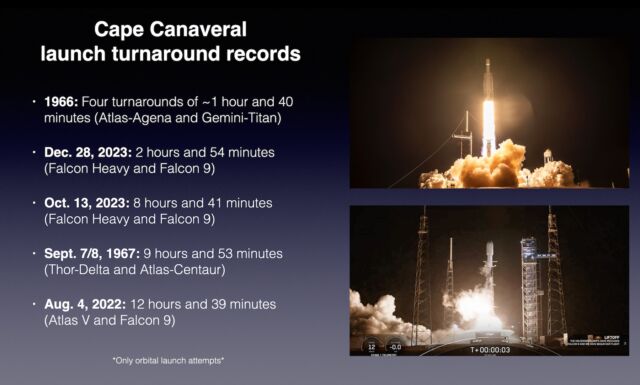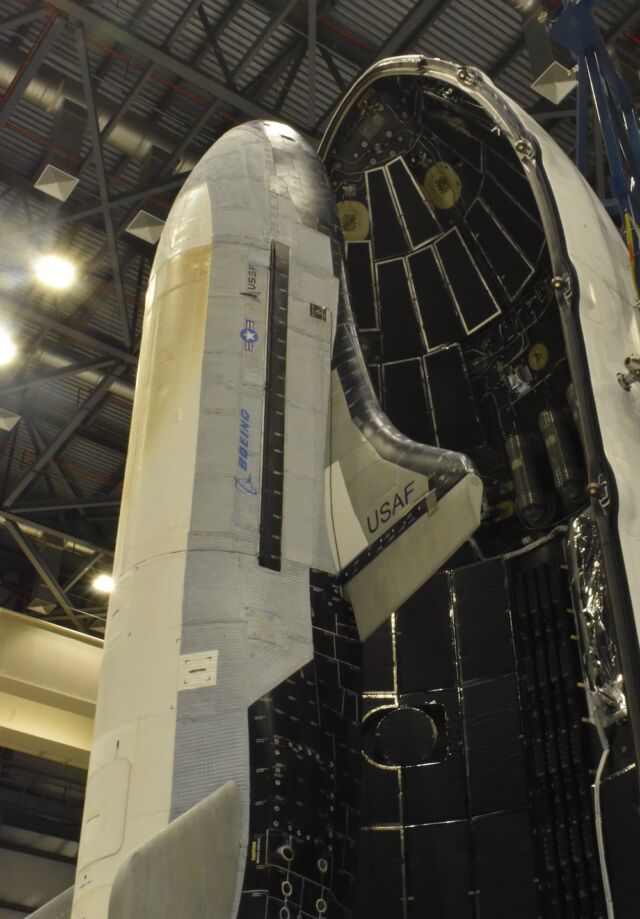This was the shortest time between orbital launches at Cape Canaveral since 1966.
It seems like SpaceX did everything this year but launch 100 times.
On Thursday night, the launch company sent two more rockets into orbit from Florida. One was a Falcon Heavy, the world's most powerful rocket in commercial service, carrying the US military's X-37B spaceplane from a launch pad at NASA's Kennedy Space Center at 8:07 pm EST (01:07 UTC). Less than three hours later, at 11:01 pm EST (04:01 UTC), SpaceX's workhorse Falcon 9 launcher took off a few miles to the south with a payload of 23 Starlink Internet satellites.
The Falcon Heavy's two side boosters and the Falcon 9's first stage landed back on Earth for reuse.
These were SpaceX's final launches of 2023. SpaceX ends the year with 98 flights, including 91 Falcon 9s, five Falcon Heavy rockets, and two test launches of the giant new Super Heavy-Starship rocket. These flights were spread across four launch pads in Florida, California, and Texas.
Elon Musk, SpaceX's founder and CEO, set a goal of 100 launches this year, up from the company's previous record of 61 in 2022. For a while, it looked like SpaceX was on track to accomplish the feat, but a spate of bad weather and technical problems with the final Falcon Heavy launch of the year kept the company short of 100 flights.
King of 'upmass'
"Congrats to the entire Falcon team at SpaceX on a record breaking 96 launches in 2023!" wrote Jon Edwards, vice president of Falcon launch vehicles at SpaceX, on the social media platform X. "I remember when Elon Musk first threw out a goal of 100 launches as a thought experiment, intended to unlock our thinking as to how we might accelerate Falcon across all levels of production and launch.
"Only a few years later and here we are," Edwards wrote. "I’m so incredibly proud to work with the best team on Earth, and so excited to see what we achieve next year."
It's important to step back and put these numbers in context. No other family of orbit-class rockets has ever flown more than 63 times in a year. SpaceX's Falcon rockets have now exceeded this number by roughly 50 percent. SpaceX's competitors in the United States, such as United Launch Alliance and Rocket Lab, managed far fewer flights in 2023. ULA had three missions, and Rocket Lab launched its small Electron booster 10 times.
Nearly two-thirds of SpaceX's missions this year were dedicated to delivering satellites to orbit for SpaceX's Starlink broadband network, a constellation that now numbers more than 5,000 spacecraft.
SpaceX also launched five missions with the Falcon Heavy rocket, created by aggregating three Falcon 9 rocket boosters together. Highlights from SpaceX's 2023 Falcon launch schedule included three crew missions to the International Space Station, and the launch of NASA's Psyche mission to explore a metallic asteroid.
In all, SpaceX's Falcon rockets hauled approximately 1,200 metric tons, or more than 2.6 million pounds, of payload mass into orbit this year. This "upmass" is equivalent to nearly three International Space Stations. Most of this was made up of mass-produced Starlink satellites.

A list of launch turnaround records at Cape Canaveral Space Force Station and Kennedy Space Center.
Stephen Clark / Images from SpaceX)
As if these statistics weren't enough, SpaceX closed out the year by, yes, setting yet another record. The back to back launches Thursday night took off 2 hours and 54 minutes apart, the shortest turnaround between two SpaceX flights in the company's history. It also set a modern era record at Cape Canaveral, Florida, with the shortest span between two orbital-class launches there since 1966. The Florida spaceport was the departure point for 72 orbital-class rockets in 2023, also an unprecedented level of launch activity there.
SpaceX looks poised to set more records next year. In 2024, SpaceX aims for an average of a dozen launches per month, for a total of 144 rocket flights. The company will get out of the starting blocks early in the new year, with two Falcon 9 launches slated for January 2 and 3.
What's that spaceplane doing?
The X-37B spaceplane that rode SpaceX's Falcon Heavy rocket into orbit Thursday night is embarking on a top secret mission. It's the seventh flight of the military's unpiloted mini-space shuttle, but this one comes with a few firsts.
It's the first time the Pentagon has used such a large rocket to launch the X-37B, which previously flew on smaller Falcon 9 or Atlas V launch vehicles. The Falcon Heavy's lift capability could propel the spaceplane to a much higher altitude than the low-Earth orbit regime where the X-37B flew on its previous missions.
That appears to be exactly what the Falcon Heavy did with Thursday night's mission.
The exact altitude the X-37B will be flying is unclear, but hobbyists and amateur sleuths who use open source information to reconstruct trajectories of top-secret military spacecraft suggest the Falcon Heavy was expected to haul the winged vehicle into an orbit that could stretch tens of thousands of miles above the planet.
What's more, the Falcon Heavy took a flight path toward the northeast from Florida's Space Coast, apparently on a path to ultimately release the X-37B on a trajectory that will take it over Earth's polar regions.
In a statement, the Space Force said this flight of the X-37B is focused on "a wide range of test and experimentation objectives." Flying in "new orbital regimes" is among the test objectives, military officials said.
"It seems to me like it might be a much higher orbit that it's going to," said Brian Weeden, director of program planning for the Secure World Foundation, which promotes sustainable and peaceful uses of outer space. "Otherwise, I don't know why they would use a Falcon Heavy, which is a pretty big thing."

The Boeing-built X-37B spaceplane before encapsulation inside the Falcon Heavy rocket.
US Space Force
Jointly managed by the Space Force and the Air Force, the X-37B spaceplane has attracted a lot of attention and speculation since its first mission in 2010. Across multiple administrations, Pentagon officials have consistently walked a narrow line between acknowledging the existence of the spaceplane and divulging limited information about its general purpose, while treating some details with the utmost secrecy. The military does not talk about where in space it flies. With a few exceptions, defense officials haven't publicly discussed specifics of what the X-37B carries into orbit.
The military has two Boeing-built X-37B spaceplanes, or Orbital Test Vehicles, in its inventory. They are reusable and designed to launch inside the payload fairing of a conventional rocket, spend multiple years in space with the use of solar power, and then return to Earth for a landing on a three-mile-long runway, either at Vandenberg Space Force Base in California or at NASA's Kennedy Space Center in Florida.
It resembles a miniature version of NASA's retired space shuttle orbiter, with wings, deployable landing gear, and black thermal protection tiles to shield its belly from the scorching heat of reentry. It measures 29 feet (about 9 meters) long, roughly a quarter of the length of NASA's space shuttle, and it doesn't carry astronauts. The X-37B has a cargo bay inside the fuselage for payloads, with doors that open after launch and close before landing.
The Falcon Heavy can lift about three times the payload mass as a Falcon 9, but it has the same payload volume. The X-37B's wingspan and length are fixed and known. This mission includes a service module mounted to the rear of the spaceplane to carry additional hardware, but the last X-37B had the same add-on and still didn't need a Falcon Heavy.
All this information, combined with airspace and maritime warning notices associated with the launch, indicated the Falcon Heavy would ultimately release its payload into an elliptical, or egg-shaped, orbit ranging tens of thousands of miles above Earth, according to Marco Langbroek, an expert in satellite tracking.
This would require at least two burns by the Falcon Heavy's upper stage, with the second engine-firing steering the X-37B into a high-inclination orbit, perhaps tilted at an angle of 70 degrees or more to the equator. It would give the X-37B, and whatever it carries onboard, sustained views over the polar regions, whereas the spaceplane's earlier missions covered ground closer to the equator.
During the past flights of the military's spaceplane, hobbyist skywatchers could track the spacecraft's orbit. The spaceplane was easily visible around dawn and dusk, but this time, the X-37B could be soaring much higher and not as readily observable from the ground with the naked eye.
"It will be interesting to see in what orbit it eventually goes, although with all uncertainty, it might be difficult to locate once on-orbit," Langbroek wrote on his website.
Here's what else we know about the X-37B's seventh flight. This mission will "expand the envelope" of the spaceplane's capabilities with "multiple cutting-edge experiments for the Department of the Air Force and its partners," said Lt. Col. Joseph Fritschen, the X-37B program director.
These experiments include investigations into new "space domain awareness technologies," the Space Force said. Space domain awareness refers to the military's ability to know what other entities, ranging from commercial operators to potential adversaries like China, are doing with their spacecraft in orbit.
"These tests are key to ensuring safe and responsible operations in space for all users of the space domain," the Space Force said.
The X-37B also carries a NASA experiment to expose plant seeds to the harsh radiation environment of long-duration spaceflight. While the NASA payload is almost certainly a secondary objective for this mission, Weeden said the presence of a radiation experiment gives some legitimacy to suggestions this mission will fly farther from Earth. "That kind of lines up with an orbit that kind of goes through multiple altitudes and multiple parts of the Van Allen Belts," he told Ars.

This illustration from COMSPOC, a commercial space situational awareness company, shows
one of the possible orbits for the X-37B's latest mission.
COMSPOC
China and Russia have raised concerns the X-37B could be a weapons platform. Weeden is skeptical of these claims.
"I've been saying for several years now that the most likely mission for the X-37B is to flight test new sensor technologies and new in-space hardware, solar panel technologies, all that kind of stuff," said Weeden, who worked on space and missile programs in the Air Force, but not the X-37B.
Examples of experiments the X-37B has flown on prior missions include electric thrusters and advanced thermal control technologies. Past X-37B missions have also deployed small satellites, both covertly and overtly.
China has its own top secret reusable spaceplane that appears to be similar in design to the X-37B. It launched for the third time earlier this month, and remains in orbit before it eventually returns to to a runway landing in China.
Gen. Chance Saltzman, the top general in the Space Force, told reporters it was "probably no coincidence" that China launched their spaceplane around the same time as the X-37B went up again.
"It's no surprise that the Chinese are extremely interested in our spaceplane, and we're extremely interested in theirs," Saltzman said. "The ability to put something into orbit, do some things, and bring it home and take a look at the results is powerful."
Source



3175x175(CURRENT).thumb.jpg.b05acc060982b36f5891ba728e6d953c.jpg)



Recommended Comments
There are no comments to display.
Join the conversation
You can post now and register later. If you have an account, sign in now to post with your account.
Note: Your post will require moderator approval before it will be visible.